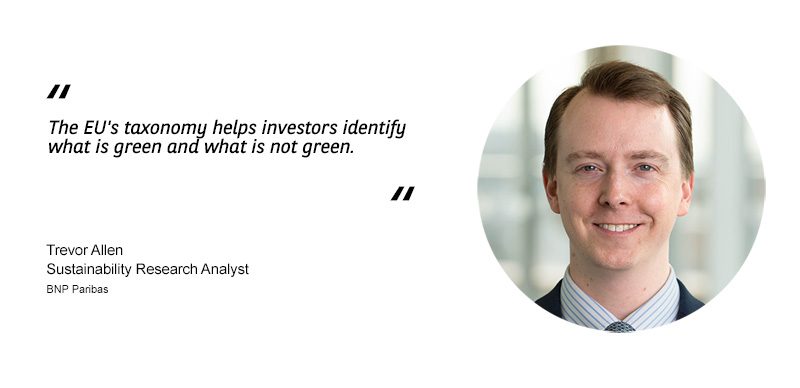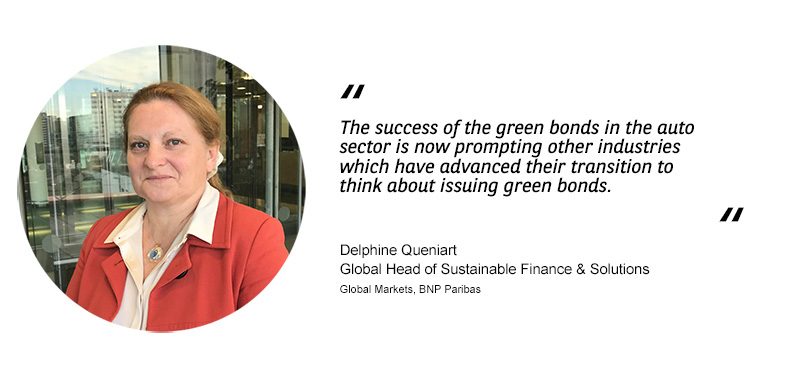Until recently it may have seemed strange
to talk about green and sustainable financing and the auto industry in the same
breath. However, even businesses with large carbon footprints are increasingly
recognising the importance of sustainability. Failure by the auto industry to
adequately future-proof its operating model to take into account the risks of
climate change would have serious ramifications. By using green financing tools
such as green bonds, auto manufacturers can further demonstrate their
commitment to invest in clean transportation and electric vehicles (EVs).
By using green financing tools such as green bonds, auto manufacturers can further demonstrate their commitment to invest in clean transportation and electric vehicles.
A number of high-profile auto manufacturers
are beginning to issue green bonds as they look to transition to a low-carbon
economy. BNP Paribas acted as joint bookrunner for Daimler‘s €1
billion, 10-year green bond designed to accelerate the company’s move towards to
a low-carbon business model. Volvo Cars recently established a Green Financing
Framework off which it has raised its debut €500 million
7-year green bond to help finance investment in EVs, with BNP Paribas acting as
structuring adviser. Volvo Cars is aiming to have 50% of its sales from fully
electric vehicles by 2025, with the rest from hybrids.
Regulators galvanise auto manufacturers into action
Regulation in the EU has been a major catalyst for green auto financing, according to Trevor Allen, sustainability research analyst at BNP Paribas. As of 2020, EU rules demand that newly built vehicles emit no more than 95g of CO2/km, otherwise manufacturers risk incurring massive fines. According to Bloomberg, auto manufacturers could be facing penalties of up $39 billion under these new emissions rules. “The regulation does have teeth,” said Allen.The EU’s Sustainable Finance Action Plan, which comes into effect in 2021, is also likely to have an impact on auto manufacturers. As part of the Action Plan, policymakers have developed a comprehensive taxonomy, a standardised classification system outlining what activities are sustainable. Regulators are hoping that making it easier for investors to benchmark sustainability will help redirect capital flows into greener assets and companies. The rules will also require institutional asset managers and asset owners to publicly disclose how they integrate sustainability risks into their investment processes.

“The EU’s taxonomy helps investors identify what is green and what is not green. It is very black and white and there are metrics across all industries including auto, steel and electricity,” said Allen.
One of the taxonomy’s primary purposes is to prevent greenwashing, whereby investors build up portfolio holdings in unsustainable assets but pass them off as being ‘green’. Agnès Gourc, Co-Head of Sustainable Finance Markets at BNP Paribas, said the new rules incentivise investment in green auto financing. Gourc said that investors buying traditional bonds issued by auto manufacturers will need to identify which parts of the issuers’ businesses are green under the taxonomy’s provisions. As a result, it is likely that only a percentage of the total investment in a traditional auto bond issue will be categorised as being taxonomy-eligible. Conversely, Gourc said that a green bond issued by an auto manufacturer would be classified as being entirely taxonomy-eligible under the EU’s rules.
Standards help drive interest
While institutions were previously highly sceptical about green auto financing, interest is now growing. This is partly because there is greater clarity around industry-wide standards for green bond issues. Gourc said that the Green Bond Principles outlined by the International Capital Markets Association (ICMA) are now firmly entrenched. She added that the EU’s Green Bond Standards have incorporated many of the principles adopted initially by ICMA, and will play a vital role in establishing best market practices.Green auto bonds: a burgeoning market
Gourc noted that the green auto financing market has evolved. As technological advancements have allowed auto manufacturers’ strategies to move towards alignment with the Paris Agreement, they have become strong candidates to access the green bond market. Investor appetite is certainly strong, evidenced by the fact that the Daimler green bond issue was more than four times oversubscribed. “There is a lot of interest coming from sustainable funds, ESG (environment, social, government) criteria funds and green bond funds, especially those in the US and EU,” commented Anjuli Pandit, Sustainability Manager for Primary Capital Markets at BNP Paribas. ESG and sustainable funds have enjoyed significant growth this year. According to Morningstar research, assets managed by sustainable investment funds have exceeded $1 trillion for the first time ever, and this is one of the few investment strategies to record net inflows during COVID-19.The appeal of green auto bonds
Investors are piling into green auto bonds for several reasons. Pandit said the need for managers to obtain portfolio diversification is a major draw. Right now, a number of sustainable funds investing in green bonds are heavily exposed to just a handful of sectors such as utilities. Pandit added that when green auto bonds began to enter the market, sustainable funds saw it as an exciting diversification opportunity. Investment in green bonds generally is also being driven by institutional investors such as pension funds and insurance companies, many of whom have integrated ESG in their financial decisions for many years. There is also a compelling risk-management case for investors to participate in the green auto bond market, as those with long-term investment horizons want assurance that their underlying holdings are viable. A refusal by a company to plan for the future or to incorporate sustainability into its corporate strategy is a risk from both an investment and credit perspective.Opening up the green bond market to other sectors
As the deal volume for the green auto bond market picks up, Delphine Queniart, Global Head of Sustainable Finance & Solutions, Global Markets at BNP Paribas, is confident that other sectors which hitherto would have been spurned by ESG investors could eventually issue green bonds of their own. “Auto was initially seen as being a tricky sector to issue green bonds a few years ago. However, the success of the green bonds in the auto sector is now prompting other industries which have advanced their transition to think about issuing green bonds,” said Queniart. With institutional investors looking to diversify their highly concentrated green bond exposure, more industries are likely to follow the auto sector and issue green bonds as they seek to decarbonise their business models.
Beyond green bonds, the sustainable finance market has now expanded to a range of other financial instruments, meaning companies can now fully integrate sustainable finance into their funding programmes with the addition of sustainability-linked loans or hedging, for example. As new industries gain access to instruments for sustainable financing, the financial markets’ potential to fight climate change and ensure a just transition is increasing significantly.
